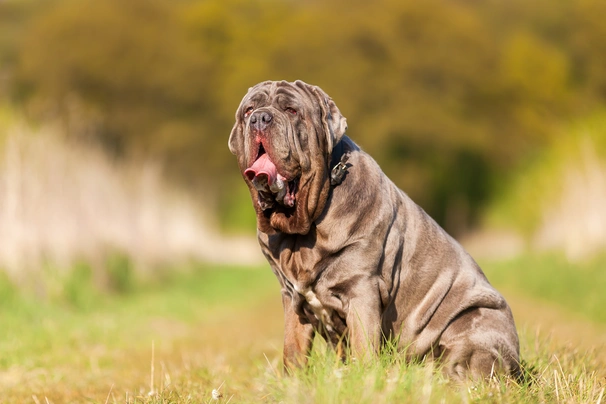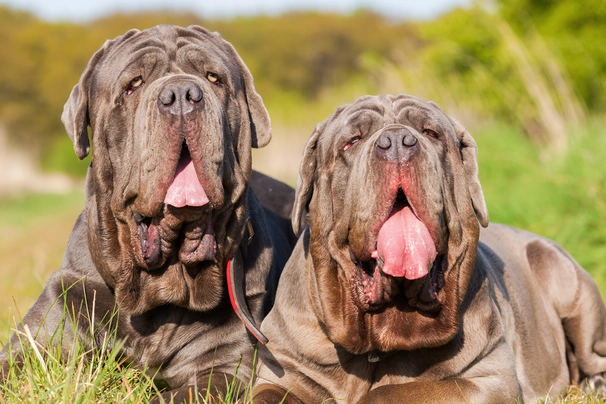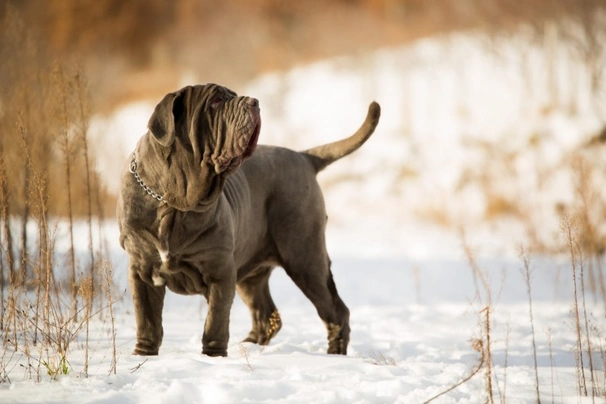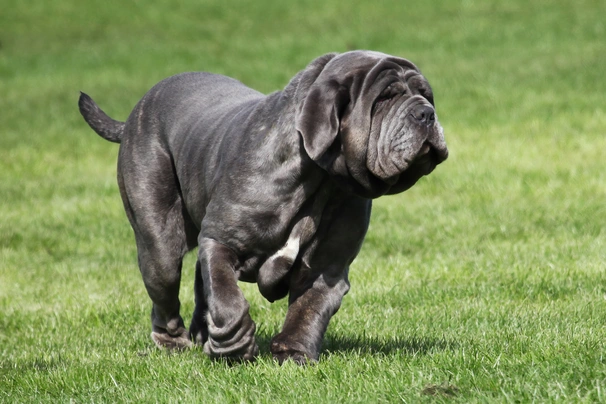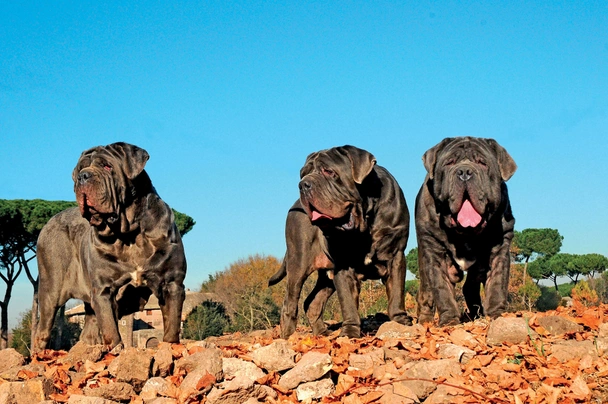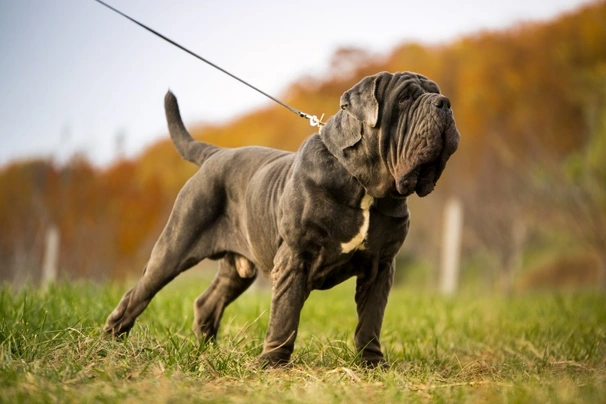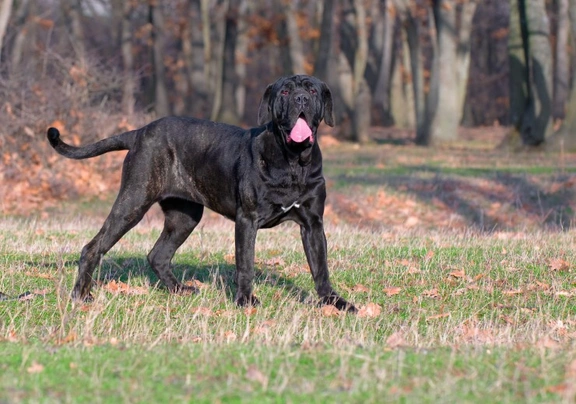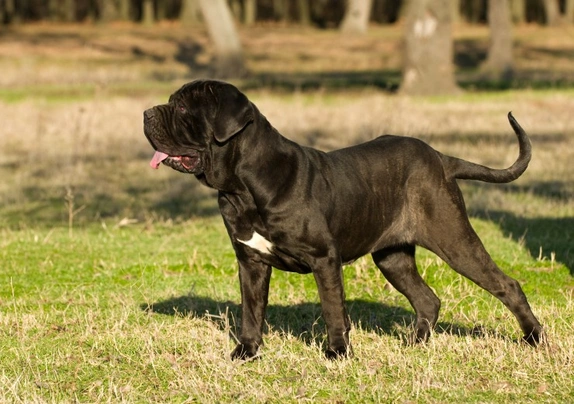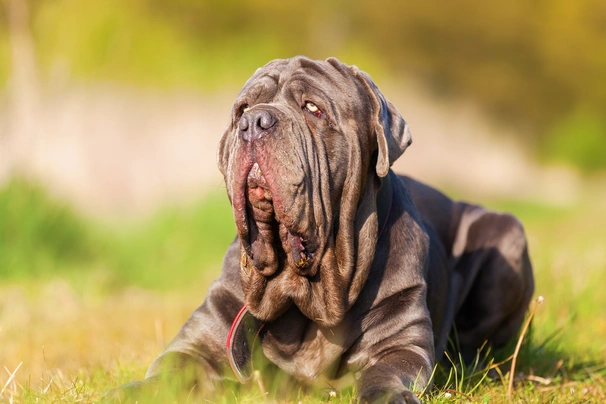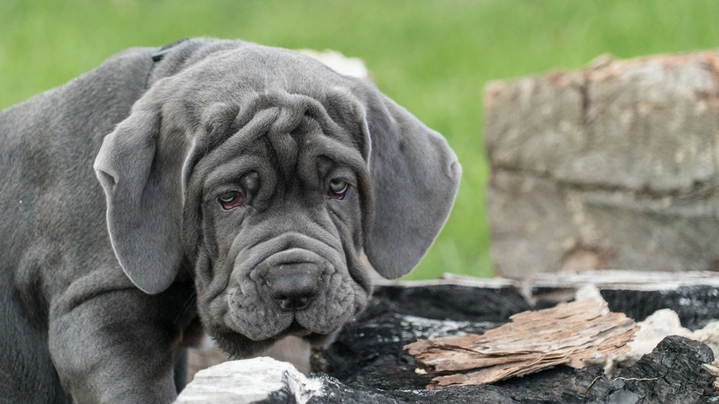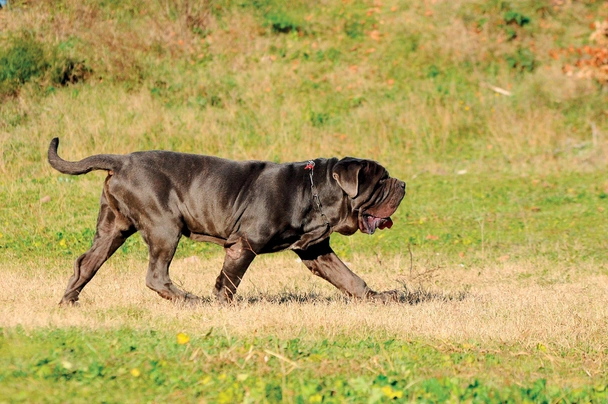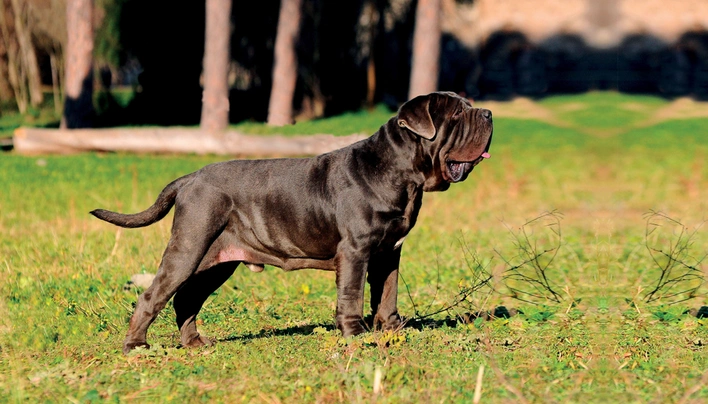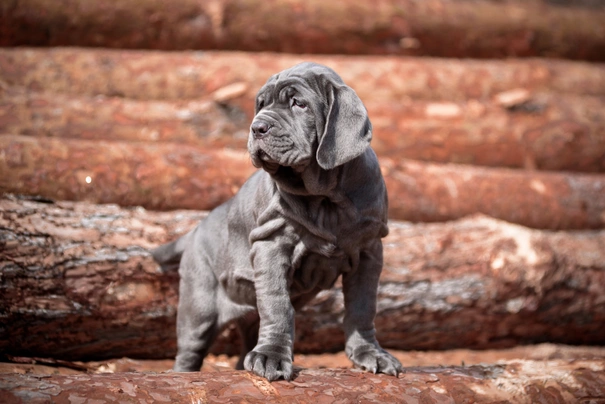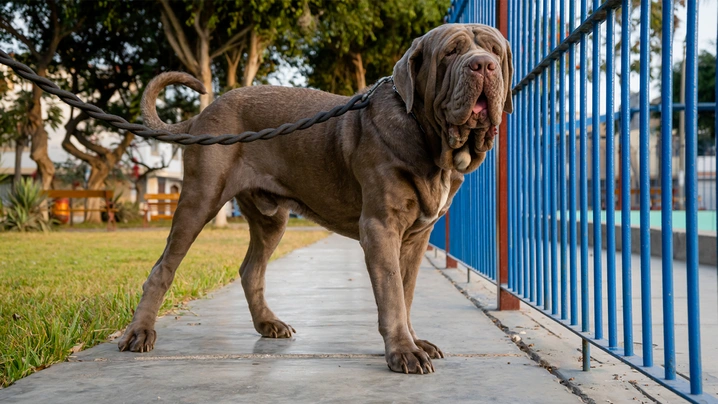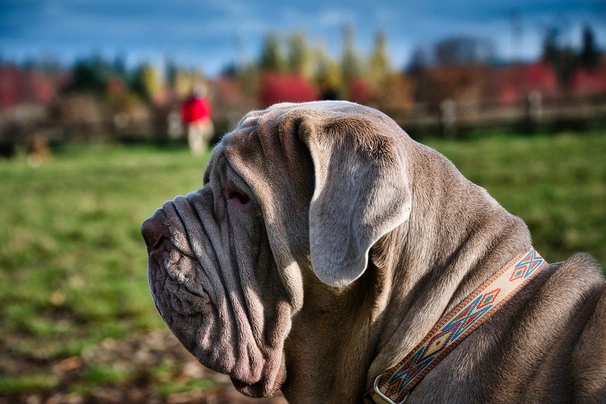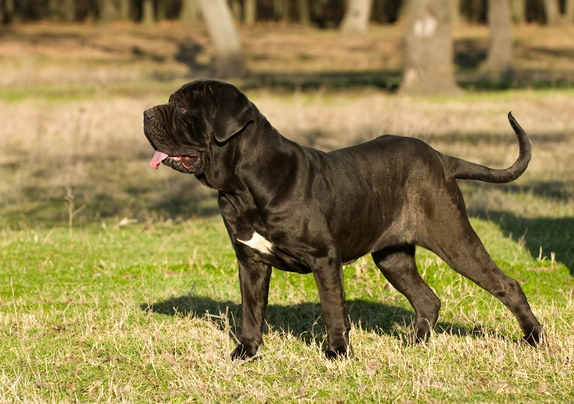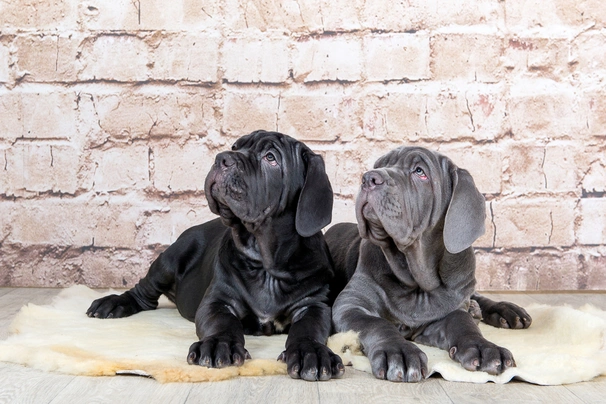Neapolitan Mastiff
Pros
Cons
Introduction of the Neapolitan Mastiff
The Neapolitan Mastiff is one of the oldest breeds around and native to Italy. Although their appearance might be a little imposing and they do make impressive watchdogs they are known for their kind and affectionate natures. They are very large and heavy dogs and they boast a tremendous amount of loose skin around their faces and necks which combined to their ultra-droopy lips adds to the Neapolitan's overall forbidding appearance.
In the right environment and given the right amount of socialisation and training it would be hard to find a more loyal and loving dog than the Neapolitan Mastiff although they are not the best choice for first time dog owners. Mastinos as they are often called also need enough room to express themselves as such large dogs need to do.
History of the Neapolitan Mastiff
The Neapolitan Mastiff are thought to have originated in Tibet over 5000 years ago and are therefore one of the oldest mastiff-type dogs around. It is also thought that they are the descendants of one of the most ancient of breeds namely the Molossus which were fighting dogs the Romans used in the arena. The Romans took these dogs with them when they invaded Europe and England leaving them behind once they left the country. The dogs were then used on farms to protect and guard livestock against predators which included wolves and bears. They were also known as Bandogs at the time and were often used as fighting dogs. However by the 1800's bull baiting was on the decline and as a result the numbers of their fell into decline which saw the breed virtually vanish altogether.
Thanks to the efforts of one man Commissioner Thompson the breed survived with the majority of Mastinos we see today being able to trace their ancestry back to one of the dogs he bred. The first dogs to be shown was in 1946 and when they were spotted by Piero Scanziani who was soon to become another breed enthusiast starting his own breeding programme a few years later. His breeding endeavours were so successful these magnificent dogs were soon accepted by the Italian Kennel Club.
Today these magnificent dogs are still highly prized by many people the world over and puppies still command a high price thanks to their charming natures and quite unique looks. However anyone wanting to share a home with a Neapolitan Mastiff might need to go on a waiting list for the pleasure of doing so.
Interesting facts about the breed
- Is the Neapolitan Mastiff a vulnerable breed? No they are one of the more popular of all large breeds having found a large fan base in the UK
- They are thought to have been around over 5000 years ago but their origins remain a bit of a mystery
- They are thought to be the descendants of dogs that were around in ancient Roman times known as the Molossus which were fighting dogs used in arenas
- The Neapolitan Mastiff is categorised as a "3" in the Kennel Club breed watch programme which means they are highlighted as being a breed that is more susceptible to health issues associated with any sort of exaggeration in a dog's conformation. This involves their eyes teeth skin breathing and a dog's ability to move
Appearance of the Neapolitan Mastiff
Height at the withers: Males 66 - 78 cm Females 60 - 73 cm
Average weight: Males up to 70 kg Females up to 60 kg
The Neapolitan Mastiff is an imposing impressive dog that has a tremendous amount of loose skin around their faces and necks. Their heads are large with dogs boasting a broad skull and a well-defined stop. Their muzzles are large deep and square with their upper lips forming a definite inverted "v" when seen from the front. Eyes are set well forward and nicely apart being slightly rounded and the rims match the tone of a dog's nose colour.
Their ears are quite small in relation to the size of a dog's head and set well apart and high. They are triangular in shape and hang flat against the cheek. The Neapolitan Mastiff has a strong jaw with a perfect scissor bite where their upper teeth neatly overlap their lower ones. They have quite short stocky necks that are extremely well-muscled and shoulders are long well-muscled and sloping. Front legs are strong and well-muscled.
Their bodies are longer than they are tall at the withers with dogs boasting a well-muscled broad chest and long well sprung ribcage. Their toplines are straight but slope from the withers slightly with the line of a dog's belly being parallel to their topline. Loins are broad and slightly rounded boasting lots of muscle. Croups are muscular broad and slightly sloping. Their back legs are strong with long powerful thighs. Feet are oval shaped with arched toes and thick dark hard pads. Their nails are curved and extremely strong with a dog's back feet being slightly smaller than their front ones. Their tails are thicker at the base and set high on a dog's topline but tapers to the tip. Dogs carry their tails level with their backs when on the move which adds to their overall balanced appearance.
When it comes to their coat the Neapolitan Mastiff has a dense short fine coat that's hard to the touch and which boasts a lovely natural sheen. The accepted breed colours for Kennel Club registration are as follows:
- Black
- Blonde
- Blue
- Blue Brindle
- Brindle
- Fawn
- Grey
- Grey Blue
- Mahogany
- Red
Gait/movement
When a Neapolitan Mastiff moves they do so at their own pace which is slowly. They have a free gait that's very bear-like. They are slow at the trot taking long strides and covering a lot of ground. A Mastino very rarely goes much faster and they don't tend to gallop.
Faults
The Kennel Club frowns on any exaggerations or departures from the breed standard and would judge the faults on how much they affect a dog's overall health and wellbeing as well as their ability to perform.
Males should have both testicles fully descended into their scrotums and it is worth noting that a dog can be a little lighter or heavier as well as slightly taller or shorter than set out in the Kennel Club breed standard which is given as a guideline only**.**
Temperament of the Neapolitan Mastiff
Although extremely large and imposing the Neapolitan Mastiff is known to be a real gentle giant and a dog that craves human contact liking nothing more than to be in a home environment and being part of the loving family. However due to their extra-large size they are not the best of choices for first time owners. They are however a very good choice for people who are familiar with this type of very large dog and who have ultra large secure gardens where their dogs can roam as they please whenever possible.
It goes without saying that a Neapolitan Mastiff makes for a very good watchdog their size and looks alone are intimidating especially to anyone who is not familiar with the breed. They are incredibly loyal to their owners but their socialisation and training must start as early as possible because these large dogs need to know their place in the pack and who is alpha dog in a household for them to be well-rounded obedient characters.
A Neapolitan Mastiff thrives on human contact and are known to be real "people" dogs. As such they are a good choice for people where one person usually stays at home when everyone else is out so that their dog is never left for too long on their own. They are not a good choice for people who are out of the house for most of the day which could lead to a Neapolitan Mastiff developing some unwanted behavioural issues which includes separation anxiety.
Are they a good choice for first time owners?
Neapolitan Mastiffs are not the best choice for first time dog owners because they need to be handled trained and managed by people who are familiar with this type of large and impressive dog. It is also worth noting that keeping a Mastino is expensive because they need to be fed a lot more food than the average dog.
What about prey drive?
Neapolitan Mastiffs have high prey drive and care should be taken when they are around pets and animals they don't already know. Care should also be taken as to where and when a Mastino can run off the lead more especially when they are around livestock or wild animals.
What about playfulness?
Mastinos have a very playful side to their natures and love to entertain and be entertained. They are known to be a little mischievous and quit accident prone when they are young. As such it's best to teach a puppy to play outside in the garden to prevent any breakages in the house.
What about adaptability?
Neapolitan Mastiffs are large dogs that need enough space to move around and express themselves as they should. As such they are not suited to apartment living but do well living in a house with a large secure back garden they can roam in whenever possible. Care should however be taken during the hotter summer months because Mastinos can overheat very quickly which could prove fatal.
What about separation anxiety?
Mastinos form strong ties with their families and dogs are never very happy when they find themselves left on their own for longer periods of time. They are better suited to people who either work from home or in households where one person stays at home when everyone else is out so they are never alone for any length of time which could see a dog suffering from separation anxiety. This can lead to them being destructive around the home which is a dog's way of relieving any stress they are feeling and a way to keep themselves entertained.
What about excessive barking?
Neapolitan Mastiffs are not known to be "barkers" but when they do they have deep loud and impressive voices. With this said they do not bark unnecessarily but rather when they are unhappy about something or left on their own for too long.
Do Neapolitan Mastiffs like water?
Some Mastinos like swimming and will take to the water whenever they can more especially when the weather is hot. However if anyone who owns a dog that does not like water should never force them to go in because it would just end up scaring them. With this said care should always be taken when walking a Neapolitan Mastiff off the lead anywhere near more dangerous watercourses just in case a dog decides to leap in and then needs rescuing because they can't get out of the water on their own. It is also important to dry off a dog's wrinkles and folds to prevent any skin issues flaring up which can happen if they remain moist.
Are Neapolitan Mastiffs good watchdogs?
Mastinos are natural watchdogs which is a trait that is deeply embedded in a dog's psyche. They do not need to be "trained" to protect or guard which could make a dog more aggressive and dominant. It is also important that potential owners meet a puppy's parents to establish they have nice calm and relaxed temperaments.
Intelligence / Trainability of the Neapolitan Mastiff
It cannot be stressed enough the importance of socialising a Neapolitan Mastiff puppy from a young age which must include introducing them to as many new situations people animals and other dogs once they have been fully vaccinated as possible so they grow up to be well-rounded obedient mature dogs. Mastinos are highly intelligent and they learn new things extremely quickly which includes the good and the bad.
However these large and impressive dogs often take their time to respond to a command which must be taken into account when training them. As such patience and understanding are of the utmost importance when their training first starts in earnest. With this in mind their training must be consistent and always fair. Like many other dogs the Mastino is quite a sensitive character by nature and as such they do not answer well to any sort of harsh correction or heavy-handed training methods. They do respond well to positive reinforcement especially when they are given their commands in a firm yet gentle way from the word go.
Like all puppies the Mastino is very cute with their wrinkly faces but they quickly grow up into large and impressive dogs. As such owners need to start out as they mean to go on by setting out ground rules and teaching a puppy what is acceptable behaviour and what is not. The first commands a Mastino puppy should be taught are as follows:
- Come
- Sit
- Stay
- Quiet
- Leave it
- Down
- Bed
Children and other
The Neapolitan Mastiff is not the best choice for people with very young families because their sheer size could pose a problem when they are around toddlers. However these larger than life dogs seem to have an affinity with older children and love being around them although any interaction between very young kids and dogs should always be well supervised by an adult. It is also crucial for parents to teach young children how to behave around dogs and when to stay away from them particularly when there is food around or during playtime.
Male Mastinos have been known to be aggressive around other male dogs but females tend to be fine around all dogs especially if they have been well socialised from a young age. It would be a mistake to trust a Mastino around smaller animals and pets which in short means any contact between them should be avoided and this includes with cats. With this said if a Mastino has grown up with a cat in the house they generally get on well together but they would think nothing of chasing a neighbour's cat if they dared venture into a garden.
Health of the Neapolitan Mastiff
The average life expectancy of a Neapolitan Mastiff is between 8 and 10 years when properly cared for and fed an appropriate good quality diet to suit their ages.
Like so many other breeds the Neapolitan Mastiff is known to suffer from a few hereditary health issues which are worth knowing about if you are planning share your home with one of these active and good-looking dogs. The conditions that seem to affect the breed the most include the following:
- Hip dysplasia - dogs should be hip scored under the BVA/KC screening scheme
- Entropion(Eyelids Folding Inwards )
- Ectropion( Eyelids Roll Outwards )
- Cherry eye - dogs should be eye tested
- Heart problems - Tests available through the breed club
- Osteochondritis dissecans (OCD)
- Skin problems
- Arthritis
- A sensitivity to anaesthetics and sedatives
- Bloat
More about health assessments
The Neapolitan Mastiff Club work closely with vets and other clubs to ensure the continued health of the breed. As such they have implemented a Health Assessment programme for Mastinos. This assessment compliments the KC/BVA Health Screening schemes that in place for the breed but does no replace them. It does however help establish a database of health issues which in turn would benefit the welfare of the Neapolitan Mastiff.
What about vaccinations?
Mastino puppies would have been given their initial vaccinations before being sold but it is up to their new owners to make sure they have their follow-up shots in a timely manner with the vaccination schedule for puppies being as follows:
- 10 -12 weeks old bearing in mind that a puppy would not have full protection straight away but would be fully protected 2 weeks after they have had their second vaccination
There has been a lot of discussion about the need for dogs to have boosters. As such it's best to talk to a vet before making a final decision on whether a dog should continue to have annual vaccinations which are known as boosters.
What about spaying and neutering?
A lot of vets these days recommend waiting until dogs are slightly older before spaying and neutering them which means they are more mature before undergoing the procedures. As such they advise neutering males and spaying females when they are between the ages of 6 to 9 months old and sometimes even when a dog is 12 months old.
Other vets recommend spaying and neutering dogs when they are 6 months old but never any earlier unless for medical reasons. With this said many breeds are different and it is always advisable to discuss things with a vet and then follow their advice on when a dog should be spayed or neutered.
What about obesity problems?
Some Neapolitan Mastiffs gain weight after they have been spayed or neutered and it's important to keep an eye on a dog's waistline just in case they do. If a dog starts to put on weight it's important to adjust their daily calorie intake and to up the amount of exercise they are given. Older dogs too are more prone to gaining weight and again it's essential they be fed and exercised accordingly because obesity can shorten a dog's life by several years. The reason being that it puts a lot of extra strain on a dog's internal organs including the heart which could prove fatal bearing in mind that Mastinos suffer from heart issues.
What about allergies?
Mastinos are prone to suffering from allergies and skin issues so it's important for a dog to see a vet sooner rather than later if one flares up. Allergies can be notoriously hard to clear up and finding the triggers can be challenging. With this said a vet would be able to make a dog with an allergy more comfortable while they try to find out the triggers which could include the following:
- Certain dog foods with high levels of grain and cereal fillers
- Airborne pollens
- Dust mites
- Environment
- Flea and tick bites
- Chemicals found in everyday household cleaning products
Participating in health schemes
All responsible Neapolitan Mastiff breeders would ensure that their stud dogs are tested for known hereditary and congenital health issues known to affect the breed by using the following schemes:
What about breed specific breeding restrictions?
Apart from the standard breeding restrictions set out by the Kennel Club for all registered breeds there are no other breed specific breeding restrictions for the Neapolitan Mastiff.
What about Assured Breeder Requirements?
The Kennel Club strongly advises that all breeders use the following schemes on their dogs:
Caring for the Neapolitan Mastiff
As with any other breed Mastinos need to be groomed on a regular basis to make sure their coats and skin are kept in top condition. They also need to be given regular daily exercise to ensure they remain fit and healthy. On top of this dogs need to be fed good quality food that meets all their nutritional needs throughout their lives**.**
Caring for a Neapolitan Mastiff puppy
Mastino puppies are boisterous and full of life which means it's essential for homes and gardens to be puppy-proofed well in advance of their arrival. A responsible breeder would have well socialised their puppies which always leads to more outgoing confident and friendly dogs right from the word go. With this said any puppy is going to feel vulnerable when they leave their mother and littermates which must be taken into account. The longer a puppy can remain with their mother the better although it should never be for too long either.
It's best to pick a puppy up when people are going to be around for the first week or so which is the time needed for a puppy to settle in. Puppy-proofing the home and garden means putting away any tools and other implements that a boisterous puppy might injure themselves on. Electric wires and cables must be put out of their reach because puppies love chewing on things. Toxic plants should be removed from flowerbeds and the home too.
Puppies need to sleep a lot to grow and develop as they should which means setting up a quiet area that's not too out of the way means they can retreat to it when they want to nap and it's important not to disturb them when they are sleeping. It's also a good idea to keep "playtime" nice and calm inside the house and to have a more active "playtime" outside in the garden which means puppies quickly learn to be less boisterous when they are inside.
The documentation a breeder provides for a puppy must have all the details of their worming date and the product used as well as the information relating to their microchip. It is essential for puppies to be wormed again keeping to a schedule which is as follows:
- Puppies should be wormed at 6 months old
- They need to be wormed again when they are 8 months old
- Puppies should be wormed when they are 10 months old
- They need to be wormed when they are 12 months old
Things you'll need for your puppy
There are certain items that new owners need to already have in the home prior to bringing a new puppy home. It's often a good idea to restrict how much space a puppy plays in more especially when you can't keep an eye on what they get up to bearing in mind that puppies are often quite boisterous which means investing in puppy gates or a large enough playpen that allows a puppy the room to express themselves while keeping them safe too. The items needed are therefore as follows:
- Good quality puppy or baby gates to fit on doors
- A good well-made playpen that's large enough for a puppy to play in so they can really express themselves as puppies like to do
- Lots of well-made toys which must include good quality chews suitable for puppies to gnaw on bearing in mind that a puppy will start teething anything from when they are 3 to 8 months old
- Good quality feed and water bowls which ideally should be ceramic rather than plastic or metal
- A grooming glove
- A slicker brush or soft bristle brush
- Dog specific toothpaste and a toothbrush
- Scissors with rounded ends
- Nail clippers
- Puppy shampoo and conditioner which must be specifically formulated for use on dogs
- A well-made dog collar or harness
- A couple of strong dog leads
- A well-made dog bed that's not too small or too big
- A well-made dog crate for use in the car and in the home that's large enough for a puppy to move around in
- Baby blankets to put in your puppy's crate and in their beds for when they want to nap or go to sleep at night
Keeping the noise down
All puppies are sensitive to noise including Mastino puppies. It's important to keep the noise levels down when a new puppy arrives in the home. TVs and music should not be played too loud which could end up stressing a small puppy out.
Keeping vet appointments
As previously mentioned Mastino puppies would have been given their first vaccinations by the breeders but they must have their follow up shots which is up to their new owners to organise. The vaccination schedule for puppies is as follows:
- 10 -12 weeks old bearing in mind that a puppy would not have full protection straight away but would only be fully protected 2 weeks after they have had their second vaccination
When it comes to boosters it's best to discuss these with a vet because there is a lot of debate about whether a dog really needs them after a certain time. However if a dog ever needed to go into kennels their vaccinations would need to be
What about older Neapolitan Mastiffs when they reach their senior years?
Older Neapolitan Mastiffs need lots of special care because as they reach their golden years they are more at risk of developing certain health concerns. Physically a dog's muzzle may start to go grey but there will be other noticeable changes too which includes the following:
- Coats become coarser
- A loss of muscle tone
- Mastinos can either become overweight or underweight
- They have reduced strength and stamina
- Older dogs have difficulty regulating their body temperature
- They often develop arthritis
- Immune systems do not work as efficiently as they once did which means dogs are more susceptible to infections
Older dogs change mentally too which means their response time tends to be slower as such they develop the following:
- They respond less to external stimuli due to impaired vision or hearing
- They tend to be a little pickier about their food
- They have a lower pain threshold
- Become intolerant of any change
- Often an older dog can feel disorientated
Living with a Mastino in their golden years means taking on a few more responsibilities but these are easily managed and should include taking a look at their diet the amount of exercise they are given how often their dog beds need changing and keeping an eye on the condition of their teeth.
Older Neapolitan Mastiffs need to be fed a good quality diet that meets their needs at this stage of their lives all the while keeping a close eye on a dog's weight. A rough feeding guide for older dogs is as follows bearing in mind they should be fed highly digestible food that does not contain any additives:
- Protein content should be anything from 14 – 21%
- Fat content should be less than 10%
- Fibre content should be less than 4%
- Calcium content should be 0.5 – 0.8%
- Phosphorous content should be 0.4 – 0.7%
- Sodium content should be 0.2 – 0.4%
Older Mastinos don't need to be given the same amount of daily exercise as a younger dog but they still need the right amount of physical activity to maintain muscle tone and to prevent a dog from putting on too much weight. All dogs need access to fresh clean water and this is especially true of older dogs when they reach their golden years because they are more at risk of developing kidney disorders.
Grooming of the Neapolitan Mastiff
Although large and impressive the Mastino is not high maintenance in the grooming department thanks to their short close coats. With this said the folds and wrinkles around their faces and on other parts of their body need to be regularly checked and cleaned when necessary. It's also essential to dry the folds after washing them because if left moist it provides the perfect environment for bacteria to flourish which could lead to an infection setting in.
They shed throughout the year although like other breeds the Mastino tends to shed more during the Spring and then again in the Autumn when more frequent grooming would be necessary to keep on top of things. Otherwise a weekly brush and a wipe over with a chamois leather would keep a Mastino's coat looking glossy and in good condition.
It's also important to check a dog's ears on a regular basis and to clean them when necessary. If too much wax builds up in a dog's ears it can lead to a painful infection which can be hard to clear up. In short prevention is often easier than cure when it comes to ear infections.
Exercise of the Neapolitan Mastiff
Mastinos need to be given the right amount of daily exercise which ideally should be a minimum of 60 to 80 minutes a day. They do feel the heat so it's essential they be walked earlier in the morning and then later in the evening during the hotter summer months.
A shorter walk in the morning would be fine but a longer more interesting one in the afternoon is a must. These dogs also like to be able to roam around a back garden as often as possible so they can really let off steam. However the fencing must be extremely secure to keep these large dogs in because if they find a weakness in the fence they will soon escape out and get into all sorts of trouble.
With this said Neapolitan Mastiff puppies should not be given too much exercise because their joints and bones are still growing and too much pressure on them could result in causing a dog a few problems later in their lives. They should not be allowed to jump up or off furniture nor should they be allowed to run up and down the stairs because this puts too much pressure on their still growing joints and limbs. Exercise should not be too vigorous until a dog is around 2 years old which is when they have usually stopped growing.
Feeding of the Neapolitan Mastiff
If you get a Neapolitan Mastiff puppy from a breeder they would give you a feeding schedule and it's important to stick to the same routine feeding the same puppy food to avoid any tummy upsets. You can change a puppy's diet but this needs to be done very gradually always making sure they don't develop any digestive upsets and if they do it's best to put them back on their original diet and to discuss things with the vet before attempting to change it again.
Older dogs are not known to be fussy or finicky eaters but this does not mean you can feed them a lower quality diet. It's best to feed a mature dog twice a day once in the morning and then again in the evening making sure it's good quality food that meets all their nutritional requirements. These dogs need to be fed a diet that contains about 24% protein. It's also important that dogs be given the right amount of exercise so they burn off any excess calories or they might gain too much weight which can lead to all sorts of health issues. Obesity can shorten a dog's life by several years so it's important to keep an eye on their waistline from the word go.
Because Mastinos are prone to suffer from bloat it is important that they be fed twice a day instead of giving them just one larger meal a day. It's also a good idea to invest in a stand to place their feed bowl which makes it easier for these large dogs to eat comfortably without having to stretch their necks down low to reach their food. Neapolitan Mastiff should never be fed just before or just after they have exercised either because this puts them more a risk of suffering from bloat. It is also worth noting that Mastinos slobber a lot especially when they are eating and many owners choose to feed their dogs outside for this reason.
Feeding guide for a Neapolitan Mastiff puppy
Puppies need to be fed a highly nutritious good quality diet for them to develop and grow as they should. As a rough guide a Neapolitan Mastiff puppy can be fed the following amounts every day making sure their meals are evenly spread out throughout the day and it's best to feed them 3 or 4 times a day:
- 2 months old - 394g to 429g depending on puppy's build
- 3 months old - 504g to 570g depending on puppy's build
- 4 months old - 556g to 634g depending on puppy's build
- 5 months old - 658g to 761g depending on puppy's build
- 6 months old - 749g to 869g depending on puppy's build
- 7 months old - 756g to 872g depending on puppy's build
- 8 months old - 755g to 872g depending on puppy's build
- 9 months old - 701g to 691g depending on puppy's build
- 10 months old - 658g to 818g depending on puppy's build
- 11 months old - 613g to 764g depending on puppy's build
- 12 months old - 574g to 711g depending on puppy's build
- 13 months old - 538g to 667g depending on puppy's build
- 14 months old - 535g to 626g depending on puppy's build
Once a puppy is 24 months old they can be fed adult dog food.
Feeding guide for an adult Neapolitan Mastiff
Once fully mature an adult Neapolitan Mastiff must be fed a good quality diet to ensure their continued good health. As a rough guide an adult Neapolitan can be fed the following amounts every day:
- Dogs weighing 60 kg can be fed 499g to 663g depending on activity
- Dogs weighing 70 kg can be fed 559g to 741g depending on activity
Neapolitan Mastiff price
If you are looking to buy a Neapolitan Mastiff you would need to pay anything from £800 to over £2500 for a well-bred pedigree puppy.
The cost of insuring a male 3-year-old Mastino in northern England would be £59.12 a month for basic cover but for a lifetime policy this would set you back £111.97 a month (quote as of February 2018). When insurance companies calculate a pet's premium they factor in several things which includes where you live in the UK and a dog's age and whether they have been neutered or spayed.
When it comes to food costs you need to buy the best quality food whether wet or dry to feed your dog throughout their lives making sure it suits the different stages of their lives. This would set you back between £70 - £80 a month. On top of this you would need to factor in veterinary costs if you want to share your home with a Neapolitan Mastiff and this includes their initial vaccinations their annual boosters the cost of neutering or spaying your dog when the time is right and their yearly health checks all of which quickly adds up to over a £1200 a year.
As a rough guide the average cost to keep and care for a Neapolitan Mastiff would be between £130 to £190 a month depending on the level of insurance cover you opt to buy for your dog but this does not include the initial cost of buying a well-bred healthy Kennel Club registered pedigree Neapolitan Mastiff puppy.
Buying advice
When visiting and buying any puppy or dog there are many important things to consider and questions to ask of the breeder/seller. You can read our generic puppy/dog advice here which includes making sure you see the puppy with its mother and to verify that the dog has been wormed and microchipped.
Neapolitan Mastiffs are one of the more popular larger breeds both in the UK and elsewhere in the world which means that well-bred healthy KC registered puppies can often command a lot of money. As such with Neapolitan Mastiffs there is specific advice questions and protocols to follow when buying a puppy which are as follows:
- Beware of online scams and how to avoid them. You may see online and other adverts by scammers showing images of beautiful Neapolitan Mastiffpuppies for sale at very low prices. However the sellers ask buyers for money up front before agreeing to deliver a puppy to a new home. Potential buyers should never buy a puppy unseen and should never pay a deposit or any other money online to a seller. You should always visit the pet at the sellers home to confirm they are genuine and make a note of their address.
- As previously touched upon Neapolitan Mastiffs are among some of the more popular larger breeds in the UK. As such there are many amateur breeders/people who breed from a dam far too often so they can make a quick profit without caring for the welfare of the puppies their dam or the breed in general. Under Kennel Club rules a dam can only produce 4 litters and she must be between a certain age to do so. Anyone wishing to buy a Neapolitan puppy should think very carefully about who they purchase their puppy from and should always ask to see the relevant paperwork pertaining to a puppy's lineage their vaccinations and their microchipping.
- Prospective owners should be very careful when considering buying a puppy with an overly heavy build or excessive dewlaps and wrinkles. Too much loose skin around a dog's face and eyes is not normal and can lead to all sorts of health issues. Puppies should also be sound and show no weakness in their hindquarters.

